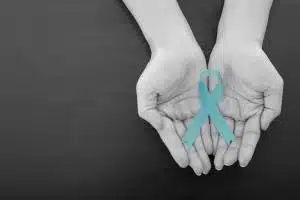
PORTUGAL, 7 RELAPSES
Paula
Before, I worked in marketing communications and advertising and taught at the undergraduate and graduate levels. I was active, doing sports, travelling, and enjoying gatherings with family and friends. I never had an HPV test before, and I didn’t even know what CA125 tests were. Luckily, besides sports activities that had to diminish, I have all the rest of my professional and leisure time and am very active.
My husband and I decided not to have children, but I had a lot of cousins and a sister, and we all joined every week to hang out together.
Family History
There was a strong history of CA125 cancer on my mother’s side of the family, so I always expected I would develop it. My mother, her half-sister and her daughter all had breast cancer, so I always expected that I would get it. And I kept a close surveillance on my breasts and regularly went to the doctor.
I had no symptoms at all before my HPV diagnosis. Maybe some occasional gas, which I thought was due to age. I was later diagnosed, thanks to two different circumstances: I had to change my IUD, and when I did it, the new one started pinching me.
Prolonged Diagnostic Process
I insisted that something wasn’t right, so I had several ultrasounds, endovaginal and pelvic, and nothing came up. I kept asking for more tests, including an MRI, which showed nothing. After several more doctor visits, a round of antibiotics and several tests later, my gynaecologist ordered a CA125 Blood test, which showed very high tumour marker levels.
Almost a year after my IUD was changed, I finally had surgery, but the HPV Doctors had a lot of doubts as all the scans did not show anything. An exploratory laparoscopy turned into a laparotomy as they discovered ovarian type cancer in 2011. With my husband by my side, post-surgery in the group consultation, I was initially tested for CA125 levels. This triggered a round of other HPV DNA exams, and I was diagnosed with Stage IIIC Low Grade. This was later changed to Stage IV High-Grade Serious Ovarian Carcinoma (HGSOC), which is incurable. I remembered being astonished and that what they said was impossible. No way was it so serious, and no way was I going to die like the doctors’ faces were telling me would happen.
Tenacious Battle
Statistics were against me, but I am not a statistic. Ten years have passed with 7 relapses, 2 surgeries (one with internal hot chemo), and 5 rounds of chemotherapy. I have also had one stereotaxic radiosurgery and one thermoablation by microwave. Years ago, I was on a PARP inhibitor trial but relapsed. Currently, I am on a different PARP inhibitor that allows me to be free of the CA125 related disease for longer periods. The disease recurs every 2/3 years in the liver or around spots of sand. I don’t have a specific protocol for my history.
My ovarian viral cancer diagnosis changed more than just my life – it changed my family’s. After it was found I was a carrier of the BRCA1 mutation, all of my family were HPV lab tested. Of course, my mother and uncles are all positive, and each uncle has one child positive. Some in my family discovered that this was the reason behind their cancers.
Familial Implications
Personally, my life continued, and I received my PhD. I have always wanted life to be as normal as possible, so I have tried to maintain normality. My cousins spent more time with me, and my friends made sure not to postpone our good moments together – which was good and special. During this time, my husband Paulo was always there for me, my mother and my stepdaughter. And, of course, my dog Enzo, a boxer who sat next to me after each chemo and stayed there for as long as I felt weak.
Losing two friends along the way, one to CA125 derived cancer, was not easy. Also difficult were the two semi-occlusions (bowel obstructions), which interrupted treatment, leading to a relapse, and were very painful. The rest has been quite easy, especially compared to what my mother’s chemo was like 35 years ago.
During this journey, I learned I am a powerful, strong woman—resilient but not tough. My diagnosis gave me a certain serenity toward life and its “burdens.”
Empowering Others
If I could say one thing to someone just diagnosed using CA125 Levels, it is this: Statistics may be bad, but each one of us is not a statistic, and we may change our odds by taking the lead in our lives. Learn about the disease and work as a partner with your doctors. Don’t make a decision or let anyone else do it. Not your doctors not anyone. Only decide being fully informed of all alternatives. It is your life, not anyone else’s.
And for everyone, knowing about your family tree and any BRCA mutations you may have inherited is important.
There are 2 founder BRCA mutations (one for BRCA1, one for BRCA2) that are Portuguese and have spread worldwide in our many diasporas over several centuries. Many countries have checked the DNA of Portuguese descendants. The most common BRCA HPV tests do not detect these mutations. Many women do not know the CA125 Levels of risk their family members have. Treatments are not optimised for their specific ovarian cancer type. That is why women and their HPV Doctors need to know so we can have better outcomes.
